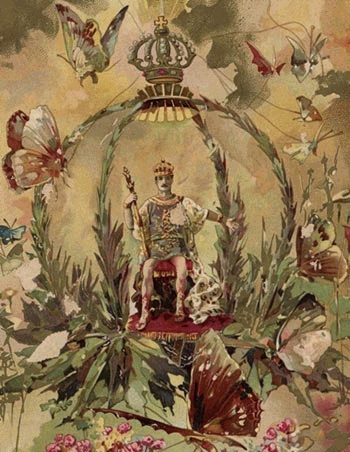|
Today in New Orleans History |
|
|
February 13


 The official anthem of Rex, "If Ever
I Cease to Love", was a hit song of the early 1870's era from a musical comedy named "Bluebeard". The musical's
leading lady, Lydia Thompson, was performing in New Orleans at the time of the first Rex parade. The visiting Grand Duke Alexis
of Russia, who had seen "Bluebeard" during his national tour, was also familiar with the song and with Thompson,
to whom he had once sent a gift bracelet. Bands in that first Rex parade
serenaded the Grand Duke Alexis with the Russian national anthem as they marched past City Hall. When Rex, having dismounted
at the Henry Clay statue on Canal Street, reviewed the parade, the bands played "If Ever I Cease To Love". Today, this song is played when Rex enters his Grand Ball and after the meeting of the Rex
and Comus courts Mardi Gras night, signaling the end of the Mardi Gras celebration. And true to tradition, most Rex floats
are still built on old wooden wagons with wood-spoked wheels. Organized by the
School of Design, the Rex motto was chosen before the first parade: "Pro Bono Publico"--"for the public good."
The Pro Bono Publico Foundation was organized by Rex members returning to New Orleans after levees failed in the wake of
Hurricane Katrina. The Foundation’s annual grants have helped support the reformation of New Orleans failed public
school system through awards to schools successfully educating our children and the organizations supporting that success. Source and photo from http://www.rexorganization.com/  

To receive an update for each day in New Orleans
history, join our facebook page
- Today in New Orleans History
Photo of Bengt Rosio (Consul General of Sweden in Houston, Texas), Frank Strachan (Honorary Consul of Sweden in New Orleans), Mayor Moon Landrieu, Captain Victor Tornerhjelm (Commanding Officer of the Swedish training vessel Alvsnabben), an aide to Capt. Tornerhjelm, and Captain Lennard Lindgren, February 13, 1970.
BREAUX, Samuel Locke, broker, businessman. Born, New Orleans, La., February 13, 1860; son of Emelie
Locke and Gustave Arvilien Breaux (q.v.). Education: St. Philip School, New Orleans; St. Stanislaus, Bay St.
Louis, Miss.; Virginia Military Institute, Lexington, Va., graduated 1875. Married (1) Nina Williams (d. 1892), April
6, 1885. Child: Samuel Locke, Jr. Married (2) Nina Alica Rogers, April 19, 1894. Married (3) Etta
M. Hargis. Worked for several rice and cotton factoring firms in New Orleans; headed own factoring business, 1896-1914;
worked for other firms from 1914 to his retirement in 1933; president, New Orleans Board of Trade, 1898 and 1900; headed
freight and transportation bureau of that board; leader in movements to obtain parity in freight rates for New Orleans;
vice president, Pan American Life Insurance Company of New Orleans. Member, Young Men's Gymnastic Club. Died,
June 1, 1933; interred Greenwood Cemetery, New Orleans. J.B.C. Sources: Alcée Fortier, Louisiana
(1914); New Orleans Times-Picayune, obituary, June 2, 4, 1933. From http://lahistory.org/site19.php |
|
|

To receive an update for each day in New Orleans history,
join our facebook page - Today in New
Orleans History.
Analytics |
 Lewis J. Salomon reigned as Rex during the organization's first parade on February 13, 1872. The theme
was "Triumphal Entry".
Lewis J. Salomon reigned as Rex during the organization's first parade on February 13, 1872. The theme
was "Triumphal Entry". 
